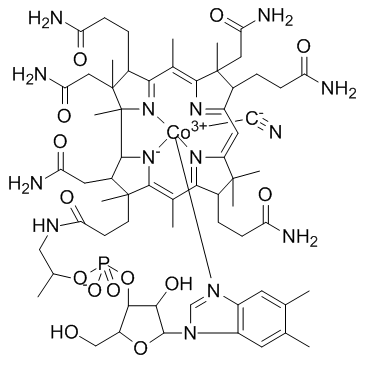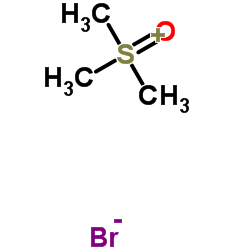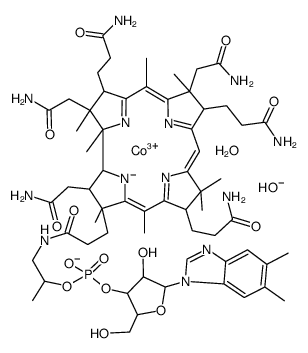Mecobalamin

Mecobalamin structure
|
Common Name | Mecobalamin | ||
|---|---|---|---|---|
| CAS Number | 13422-55-4 | Molecular Weight | 1344.382 | |
| Density | N/A | Boiling Point | N/A | |
| Molecular Formula | C63H91CoN13O14P | Melting Point | >190°C (dec.) | |
| MSDS | Chinese USA | Flash Point | N/A | |
Use of MecobalaminMethylcobalamin a cobalamin, is a form of vitamin B12.Target: OthersMethylcobalamin is a cobalamin, a form of vitamin B12. It differs from cyanocobalamin in that the cyanide is replaced by a methyl group. Methylcobalamin features an octahedral cobalt(III) centre. Methylcobalamin can be obtained as bright red crystals. From the perspective of coordination chemistry, methylcobalamin is notable as a rare example of a compound that contains metal-alkyl bonds. Methylcobalamin is equivalent physiologically to vitamin B12, and can be used to prevent or treat pathology arising from a lack of vitamin B12 (vitamin B12 deficiency), such as pernicious anemia. Methylcobalamin is also used in the treatment of peripheral neuropathy, diabetic neuropathy, and as a preliminary treatment for amyotrophic lateral sclerosis. From Wikipedia. |
| Name | methylcobalamin |
|---|---|
| Synonym | More Synonyms |
| Description | Methylcobalamin a cobalamin, is a form of vitamin B12.Target: OthersMethylcobalamin is a cobalamin, a form of vitamin B12. It differs from cyanocobalamin in that the cyanide is replaced by a methyl group. Methylcobalamin features an octahedral cobalt(III) centre. Methylcobalamin can be obtained as bright red crystals. From the perspective of coordination chemistry, methylcobalamin is notable as a rare example of a compound that contains metal-alkyl bonds. Methylcobalamin is equivalent physiologically to vitamin B12, and can be used to prevent or treat pathology arising from a lack of vitamin B12 (vitamin B12 deficiency), such as pernicious anemia. Methylcobalamin is also used in the treatment of peripheral neuropathy, diabetic neuropathy, and as a preliminary treatment for amyotrophic lateral sclerosis. From Wikipedia. |
|---|---|
| Related Catalog | |
| References |
| Melting Point | >190°C (dec.) |
|---|---|
| Molecular Formula | C63H91CoN13O14P |
| Molecular Weight | 1344.382 |
| Exact Mass | 1343.587769 |
| PSA | 463.87000 |
| LogP | 7.19930 |
| Storage condition | −20°C |
| Water Solubility | Partially soluble in cold water, hot water. |
|
Section 1. Chemical Product and Company Identification MethylcobalaminCatalog YY727, M1587 Common Name/ Number(s). Trade Name CAS#13422-55-4
Manufacturer Commercial Name(s) Methylcobalamin Section 4. First Aid Measures Eye ContactCheck for and remove any contact lenses. In case of contact, immediately flush eyes with plenty of water for at least 15 minutes. Cold water may be used. Get medical attention if irritation occurs. Skin ContactWash with soap and water. Cover the irritated skin with an emollient. Get medical attention if irritation develops. Cold water may be used. Serious Skin ContactNot available. InhalationIf inhaled, remove to fresh air. If not breathing, give artificial respiration. If breathing is difficult, give oxygen. Get medical attention. Serious InhalationNot available. IngestionDo NOT induce vomiting unless directed to do so by medical personnel. Never give anything by mouth to an unconscious person. Loosen tight clothing such as a collar, tie, belt or waistband. Get medical attention if symptoms appear. Serious IngestionNot available. Section 5. Fire and Explosion Data Flammability of the Product May be combustible at high temperature. Auto-Ignition Temperature Not available. Flash PointsNot available. Flammable LimitsNot available. These products are carbon oxides (CO, CO2), nitrogen oxides (NO, NO2...). Some metallic oxides. Products of Combustion Fire Hazards in Presence of Slightly flammable to flammable in presence of heat. Various SubstancesNon-flammable in presence of shocks. Explosion Hazards in Presence Risks of explosion of the product in presence of mechanical impact: Not available. of Various SubstancesRisks of explosion of the product in presence of static discharge: Not available. Fire Fighting MediaSMALL FIRE: Use DRY chemical powder. and InstructionsLARGE FIRE: Use water spray, fog or foam. Do not use water jet. Special Remarks onAs with most organic solids, fire is possible at elevated temperatures Fire Hazards Special Remarks on Explosion Fine dust dispersed in air in sufficient concentrations, and in the presence of an ignition source is a potential dust Hazardsexplosion hazard. Section 6. Accidental Release Measures Small SpillUse appropriate tools to put the spilled solid in a convenient waste disposal container. Finish cleaning by spreading water on the contaminated surface and dispose of according to local and regional authority requirements. Large Spill Use a shovel to put the material into a convenient waste disposal container. Finish cleaning by spreading water on the contaminated surface and allow to evacuate through the sanitary system. Methylcobalamin Section 7. Handling and Storage PrecautionsKeep away from heat. Keep away from sources of ignition. Ground all equipment containing material. Do not ingest. Do not breathe dust. If ingested, seek medical advice immediately and show the container or the label. Keep away from incompatibles such as oxidizing agents. StorageKeep container tightly closed. Keep container in a cool, well-ventilated area. Do not store above 0°C (32°F). Freeze. Section 8. Exposure Controls/Personal Protection Engineering ControlsUse process enclosures, local exhaust ventilation, or other engineering controls to keep airborne levels below recommended exposure limits. If user operations generate dust, fume or mist, use ventilation to keep exposure to airborne contaminants below the exposure limit. Personal ProtectionSafety glasses. Lab coat. Dust respirator. Be sure to use an approved/certified respirator or equivalent. Gloves. Personal Protection in Case of Splash goggles. Full suit. Dust respirator. Boots. Gloves. A self contained breathing apparatus should be used a Large Spillto avoid inhalation of the product. Suggested protective clothing might not be sufficient; consult a specialist BEFORE handling this product. Exposure LimitsNot available. Section 9. Physical and Chemical Properties Physical state and appearance Solid. (Solidcrystalline powder.)OdorOdorless. TasteNot available. Molecular Weight1344.4 g/mole ColorRed. pH (1% soln/water)Not available. Not available. Boiling Point Melting PointNot available. Not available. Critical Temperature Specific GravityNot available. Vapor PressureNot applicable. Vapor DensityNot available. VolatilityNot available. Odor ThresholdNot available. Water/Oil Dist. Coeff.Not available. Ionicity (in Water)Not available. Dispersion PropertiesSee solubility in water. SolubilityPartially soluble in cold water, hot water. Section 10. Stability and Reactivity Data The product is stable. Stability Instability TemperatureNot available. Conditions of InstabilityExcess heat, dust generation, incompatibles. Reactive with oxidizing agents. Incompatibility with various substances Not available. Corrosivity Methylcobalamin Not available. Special Remarks on Reactivity Not available. Special Remarks on Corrosivity PolymerizationWill not occur. Section 11. Toxicological Information Routes of EntryInhalation. Ingestion. Toxicity to AnimalsAcute oral toxicity (LD50): 5000 mg/kg [Rat]. Chronic Effects on Humans Not available. Other Toxic Effects onSlightly hazardous in case of skin contact (irritant), of ingestion, of inhalation. Humans Special Remarks on Not available. Toxicity to Animals Special Remarks onMay cause adverse reproductive and birth defects based on animal data. Chronic Effects on HumansMay cause cancer (tumorigenic) based on animal data Special Remarks on otherAcute Potential Health Effects: Toxic Effects on HumansSkin: May cause skin irritation. Eyes: Dust may cause eye irritation. Inhalation: Dust may cause respiratory tract irritation. Ingestion: May cause gastrointestinal tract irritation. Section 12. Ecological Information EcotoxicityNot available. Not available. BOD5 and COD Possibly hazardous short term degradation products are not likely. However, long term degradation products may Products of Biodegradation arise. Toxicity of the ProductsThe product itself and its products of degradation are not toxic. of Biodegradation Special Remarks on theNot available. Products of Biodegradation Section 13. Disposal Considerations Waste DisposalWaste must be disposed of in accordance with federal, state and local environmental control regulations. Section 14. Transport Information DOT ClassificationNot a DOT controlled material (United States). Not applicable. Identification Special Provisions forNot applicable. Transport Methylcobalamin DOT (Pictograms) Section 15. Other Regulatory Information and Pictograms No products were found. Federal and State Regulations CaliforniaCalifornia prop. 65: This product contains the following ingredients for which the State of California has found to cause cancer which would require a warning under the statute: No products were found. Proposition 65 Warnings California prop. 65: This product contains the following ingredients for which the State of California has found to cause birth defects which would require a warning under the statute: No products were found. Other RegulationsEINECS: This product is on the European Inventory of Existing Commercial Chemical Substances (EINECS No. 236-535-3). Canada: Not listed on Canadian Domestic Substance List (DSL) or Canadian Non-Domestic Substances List (NDSL). China: Not listed on National Inventory. Japan: Not listed on National Inventory (ENCS). Korea: Not listed on National Inventory (KECI). Philippines: Not listed on National Inventory (PICCS). Australia: Listed on AICS. WHMIS (Canada) Not controlled under WHMIS (Canada). Other Classifications DSCL (EEC)This product is not classified according Not applicable. to the EU regulations. Health Hazard HMIS (U.S.A.)1 National Fire Protection 1 Flammability 1 Association (U.S.A.) Fire Hazard 1 0 Reactivity Health Reactivity 0 Specific hazard Personal Protection E WHMIS (Canada) (Pictograms) DSCL (Europe) (Pictograms) TDG (Canada) (Pictograms) ADR (Europe) (Pictograms) Protective Equipment Gloves. Methylcobalamin Lab coat. Dust respirator. Be sure to use an approved/certified respirator or equivalent. SECTION 16 - ADDITIONAL INFORMATION N/A |
CHEMICAL IDENTIFICATION
HEALTH HAZARD DATAACUTE TOXICITY DATA
|
| Hazard Codes | Xi: Irritant; |
|---|---|
| Risk Phrases | R36/37/38 |
| Safety Phrases | 24/25-36-26 |
| RIDADR | NONH for all modes of transport |
| WGK Germany | 2 |
| RTECS | GG3745000 |
| HS Code | 2936260000 |
|
~85% 
Mecobalamin CAS#:13422-55-4 |
| Literature: Eisai Co., Ltd. Patent: EP1394174 A1, 2004 ; Location in patent: Page 7-9 ; |
|
~% 
Mecobalamin CAS#:13422-55-4 |
| Literature: EP1394174 A1, ; Page 6 ; |
| Precursor 2 | |
|---|---|
| DownStream 1 | |
| HS Code | 2936260000 |
|---|
|
Environmental fate of the next generation refrigerant 2,3,3,3-tetrafluoropropene (HFO-1234yf).
Environ. Sci. Technol. 48(22) , 13181-7, (2014) The hydrofluoroolefin 2,3,3,3-tetrafluoropropene (HFO-1234yf) has been introduced to replace 1,1,1,2-tetrafluoroethane (HFC-134a) as refrigerant in mobile, including vehicle, air conditioning systems ... |
|
|
Thin-layer chromatography combined with diode laser thermal vaporization inductively coupled plasma mass spectrometry.
J. Chromatogr. A. 1364 , 271-5, (2014) Here we present a novel coupling of thin-layer chromatography (TLC) to diode laser thermal vaporization inductively coupled plasma mass spectrometry (DLTV ICP MS). DLTV is a new technique of aerosol g... |
|
|
Processing of alkylcobalamins in mammalian cells: A role for the MMACHC (cblC) gene product.
Mol. Genet. Metab. 97 , 260-266, (2009) The MMACHC gene product of the cblC complementation group, referred to as the cblC protein, catalyzes the in vitro and in vivo decyanation of cyanocobalamin (vitamin B(12)). We hypothesized that the c... |
| methycobal |
| methyl-b12 |
| Methylcobaz |
| mbl-a |
| Algobaz |
| Hitocobamin-M |
| MeCbl |
| MFCD00082483 |
| Methylcobalamin |
| Mecobalamin |
| MECOBALAMINE |
| EINECS 236-535-3 |



 CAS#:13422-52-1
CAS#:13422-52-1
